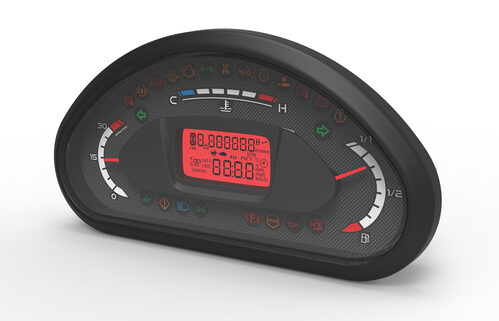Quik, MTA's new cockpit. Convenient and customizable
Codogno, Italy, October 15th, 2015
MTA SpA, a leading company in the design and production of electromechanical and electronic products supplied to the main OEMs, introduces during Agritechnica 2015 Quik, its new electronic project: a cockpit developed entirely in-house conceived for a wide application market. This off-the-shelf product is ready to use, offering a convenient, „quick“ solution that customers may tailor to their needs thanks to its exceptional configurability.
The Quik cockpit has a contemporary look, designed by a design agency, and a compact size (230X120 mm) that makes it ideal for agricultural machinery. It features a segment-style central LCD; 2 gauge-style analog indicators in mirror-like arrangement; 1 LED bar indicator at the top; 23 LED warning lights, 1 real timer clock and a buzzer, one Can line with termination that can be configured with up to 23 configurable digital inputs, 2 analog inputs, 2 frequency counters and one 500 mA output.
One hardware fits all
LCD backlighting and pointers are available in black or white. Yet more options are available to customers, who can choose the colours and icons of the warning lights and the style and colours of LED bar and analog gauge scales. The inner frame enclosing the LCD is also available in several different colours, and the front bezel may be black or a custom colour. The same is true of the PMMA instrument cluster glazing, which is available with an optional anti-fog coating applied by a specific machine at MTA Rolo site. There is also room for the customer's custom logo. The cluster operates on 12V or 24V and there are two fastening options available – with or without front bezel.
The software – customization at its best
The software of this device can be customized directly by the customer, or by MTA, using a PC tool that not only enables cluster configuration, but also lets you program operating logics in C/C++, LADDER , FBD. The WhatYouSeeIsWhatYouGet interface for the graphic HMI offers users a preview of what the final graphics will look like while they are creating the software. The software made available to customers also includes a real time debugger and a set of libraries with different functions for customers to call depending on specific application needs.

- Quik, MTA's new cockpit
 Download pictures
Download pictures